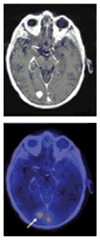Therapeutic approaches for HER2-positive brain metastases: circumventing the blood-brain barrier
- PMID: 22727691
- PMCID: PMC4432469
- DOI: 10.1016/j.ctrv.2012.05.006
Therapeutic approaches for HER2-positive brain metastases: circumventing the blood-brain barrier
Abstract
We aim to summarize data from studies of trastuzumab in patients with human epidermal growth factor receptor 2 (HER2)-positive metastatic breast cancer (MBC) and brain metastasis and to describe novel methods being developed to circumvent the blood-brain barrier (BBB). A literature search was conducted to obtain data on the clinical efficacy of trastuzumab and lapatinib in patients with HER2-positive MBC and brain metastasis, as well as the transport of therapeutic molecules across the BBB. Trastuzumab-based therapy is the standard of care for patients with HER2-positive MBC. Post hoc and retrospective analyses show that trastuzumab significantly prolongs overall survival when given after the diagnosis of central nervous system (CNS) metastasis; this is probably attributable to its control of extracranial disease, although trastuzumab may have a direct effect on CNS disease in patients with local or general perturbation of the BBB. In patients without a compromised BBB, trastuzumab is thought to have limited access to the brain, because of its relatively large molecular size. Several approaches are being developed to enhance the delivery of therapeutic agents to the brain. These include physical or pharmacologic disruption of the BBB, direct intracerebral drug delivery, drug manipulation, and coupling drugs to transport vectors. Available data suggest that trastuzumab extends survival in patients with HER2-positive MBC and brain metastasis. Novel methods for delivery of therapeutic agents into the brain could be used in the future to enhance access to the CNS by trastuzumab, thereby improving its efficacy in this setting.
Copyright © 2012 Elsevier Ltd. All rights reserved.
Conflict of interest statement
Drs. Brufsky, Mehta and Sampson have no financial disclosures impacting this manuscript. This research was supported in part by National Institutes of Health grants 5R25-NS065731-02 (AIM, JHS), RO1-CA97222-05 (JHS), 5P50 NS20023 (DDB, JHS), and 5P50 CA108786 (DDB, JHS), and by grants from the American Brain Tumor Association (JHS), the Accelerate Brain Cancer Cure (JHS), and the Brain Tumor Society (JHS).
Figures





References
-
- Patel RR, Mehta MP. Targeted therapy for brain metastases: improving the therapeutic ratio. Clin Cancer Res. 2007;13:1675–83. - PubMed
-
- Vogelbaum MA, Suh JH. Resectable brain metastases. J Clin Oncol. 2006;24:1289–94. - PubMed
-
- Chang JE, Robins HI, Mehta MP. Therapeutic advances in the treatment of brain metastases. Clin Adv Hematol Oncol. 2007;5:54–64. - PubMed
-
- Palmieri D, Chambers AF, Felding-Habermann B, Huang S, Steeg PS. The biology of metastasis to a sanctuary site. Clin Cancer Res. 2007;13:1656–62. - PubMed
-
- Miller KD, Weathers T, Haney LG, et al. Occult central nervous system involvement in patients with metastatic breast cancer: prevalence, predictive factors and impact on overall survival. Ann Oncol. 2003;14:1072–7. - PubMed
Publication types
MeSH terms
Substances
Grants and funding
LinkOut - more resources
Full Text Sources
Other Literature Sources
Medical
Research Materials
Miscellaneous

